Magma formation - Study guides, Class notes & Summaries
Looking for the best study guides, study notes and summaries about Magma formation? On this page you'll find 216 study documents about Magma formation.
Page 4 out of 216 results
Sort by
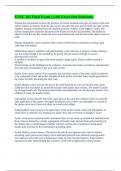
-
EASC 101 Final Exam || with Error-free Solutions.
- Exam (elaborations) • 5 pages • 2024
-
- $10.49
- + learn more
Explain the relationship between the presence of certain elements and types of matter in the solar system relative to distance from the sun. correct answers The suns gravity holds the solar system together, keeping everything from the smallest particles of debris to the biggest in orbit. The surface temperature of planets decrease as the distance from the sun increases. The farther an object is from the sun, the weaker the Sun's gravitational pull, and the slower the object moves in orbit. N...
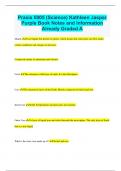
-
Praxis 5005 (Science) Kathleen Jasper Purple Book Notes and Information Already Graded A
- Exam (elaborations) • 36 pages • 2023
- Available in package deal
-
- $10.99
- + learn more
Praxis 5005 (Science) Kathleen Jasper Purple Book Notes and Information Already Graded A Mantle Is not liquid, but ductile or plastic, which means that some parts can flow under certain conditions and changes in pressure. Composed mainly of aluminum and silicates Crust The outermost solid layer of earth. It is the lithosphere. Core The innermost layers of the Earth. Mainly composed of nickel and iron Inner Core Solid. Temperatures and pressures are extreme. Outer Core A layer of liquid iron...
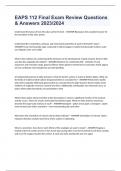
-
EAPS 112 Final Exam Review Questions & Answers 2023/2024
- Exam (elaborations) • 32 pages • 2023
-
Available in package deal
-
- $10.99
- + learn more
EAPS 112 Final Exam Review Questions & Answers 2023/2024 Understand the basics of how the solar system formed. - ANSWER-Big bang is the accepted manner for the formation of the solar system Understand the composition, physical, and mechanical properties of each of the Earth's layers - ANSWER-Crust (mechanically rigid, composed of silicon/oxygen), mantle (mechanically molten), outer core (liquid), inner core (solid) What is the evidence for continental drift cited prior to the developme...

-
astro 7 Question and answers 2024 verified to pass
- Exam (elaborations) • 5 pages • 2024
-
Available in package deal
-
- $13.99
- + learn more
astro 7 Question and answers 2024 verified to passastro 7 terrestrial planet - correct answer An Earth-like planet, made of rock and metal and having a solid surface. In our Solar System, the terrestrial planets are Mercury, Venus, Earth, and Mars. comparative planetology - correct answer The study of planets through comparison of their chemical and physical properties. hydrosphere - correct answer The portion of Earth that is largely liquid water. lithosphere - correct answer The ...

-
UST 289 Final Exam (A+ GRADED)
- Exam (elaborations) • 6 pages • 2024
- Available in package deal
-
- $9.69
- + learn more
Geomorphology correct answers study of the shape of the Earth's features and how they change over time Present era of timescale correct answers Cenozoic era Radiometric dating correct answers rate of radioactive decay of rock elements to determine the age of rocks Timescale for geologic change correct answers history of the Earth since its formation as spanning a single 24 hour day, long time frame, relatively short period of evolving life forms Endogenic correct answers internal pr...

-
Geology 107: Homework Study Guide.
- Exam (elaborations) • 3 pages • 2024
-
Available in package deal
-
- $11.49
- + learn more
Geology 107: Homework Study Guide. The more silica in magma, the lower the viscosity. - CORRECT ANSWER False As a result of partial melting, magma originates in __________. - CORRECT ANSWER the mantle and crust When lava erupts at Earth's surface, what type of rock is produced? - CORRECT ANSWER extrusive Pyroclastic debris from a volcanic eruption can include _____. - CORRECT ANSWER ash and cinders Why does magma have a tendency to rise after its formation? - CORRECT ANSWER It ...
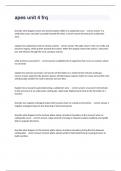
-
apes unit 4 frq with 100% correct solutions 2024/2025
- Exam (elaborations) • 2 pages • 2024
- Available in package deal
-
- $13.49
- + learn more
apes unit 4 frq with 100% correct solutions 2024/2025describe what happens when two tectonic plates collide in a subduction zone - correct answer in a subduction zone, one plate is pushed beneath the other. a trench may be formed at the subduction zone. explain how subduction leads to volcanic activity - correct answer The plate closer to the core melts and becomes magma, which pushes towards the surface. When the magma reaches the surface, it becomes lava and releases through the crust cau...

-
Geology 102 Binghamton, sample final -exam mid term and quiz 2 review Questions With 100% Correct Answers.
- Exam (elaborations) • 4 pages • 2024
- Available in package deal
-
- $7.99
- + learn more
____________ have provided geologists with the best estimate of the maximum temperature at the mantle/core boundary. - Experimental studies on the melting of pure iron a geothermal gradient is the rate of change in the ______________ with depth. - temperature A planetary body must eventually lose all of its heat out of its surface to space by the process of - radiation All ring systems of the outer planets lie within the ___________________________ limit of the host planet. - Roche Basalt...
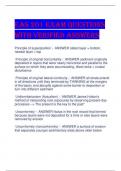
-
EAS 201 Exam Questions With Verified Answers
- Exam (elaborations) • 17 pages • 2023
-
- $12.99
- + learn more
EAS 201 Exam Questions With Verified Answers Principle of superposition - ANSWER oldest layer = bottom, newest layer = top Principle of original horizontality - ANSWER sediment originally deposited in layers that were nearly horizontal and parallel to the surface on which they were accumulating, tilted rocks = crustal disturbance Principle of original lateral continuity - ANSWER all strata extend in all directions until they terminate by THINNING at the margins of the basin, end...

-
UBC EOSC 114 exam with complete solutions
- Exam (elaborations) • 25 pages • 2024
-
- $10.99
- + learn more
Work W = f x d The force that pushes an object times the distance the object moves Potential energy The work needed to raise an object a distance against the pull of gravity Previous Play Next Rewind 10 seconds Move forward 10 seconds Unmute 0:02 / 0:15 Full screen Brainpower Read More Kinetic energy The energy an object has due to its motion Sensible heat Heat energy we can feel or measure Latent heat Hidden heat energy in chemical bonds Released...

$6.50 for your textbook summary multiplied by 100 fellow students... Do the math: that's a lot of money! Don't be a thief of your own wallet and start uploading yours now. Discover all about earning on Stuvia


